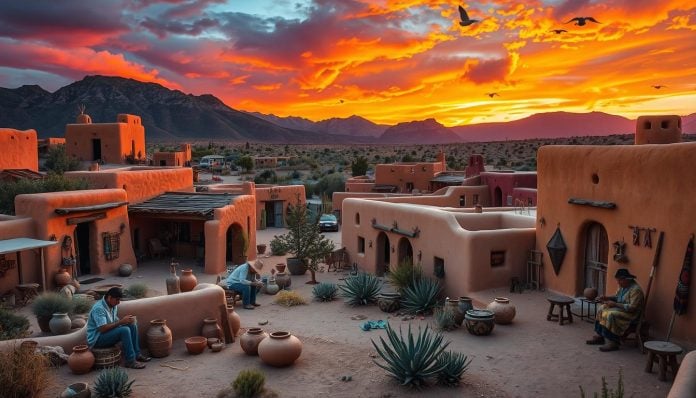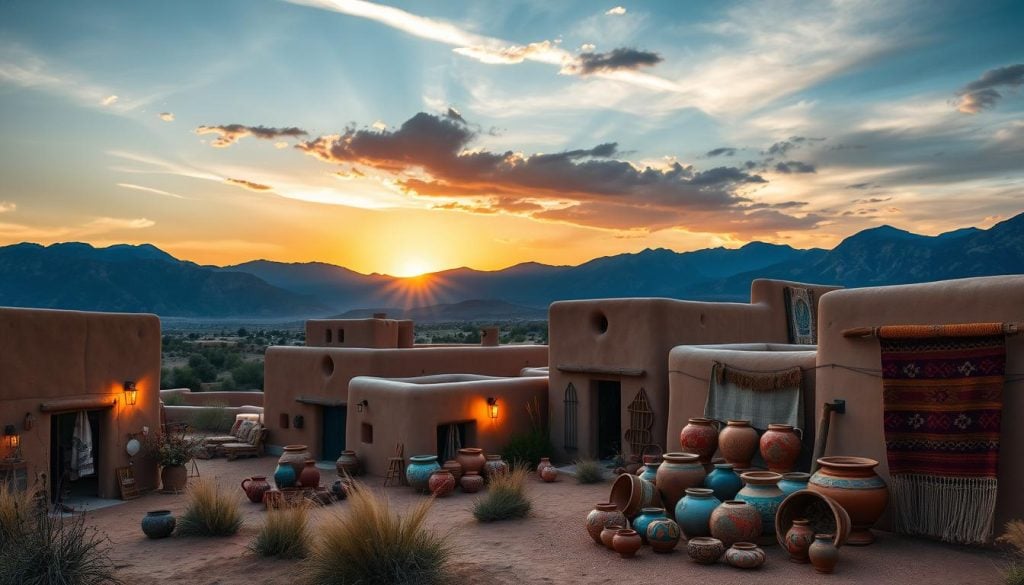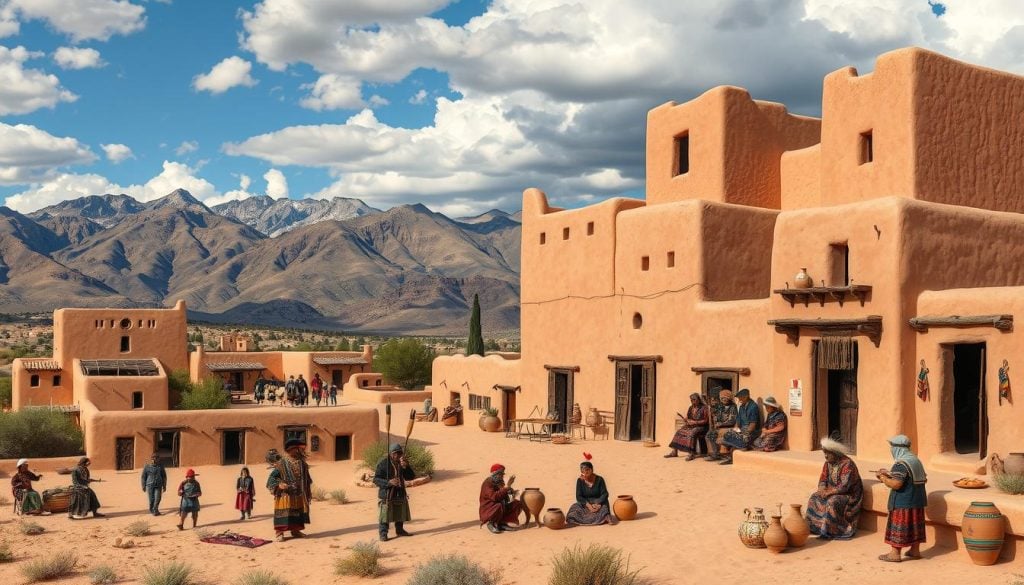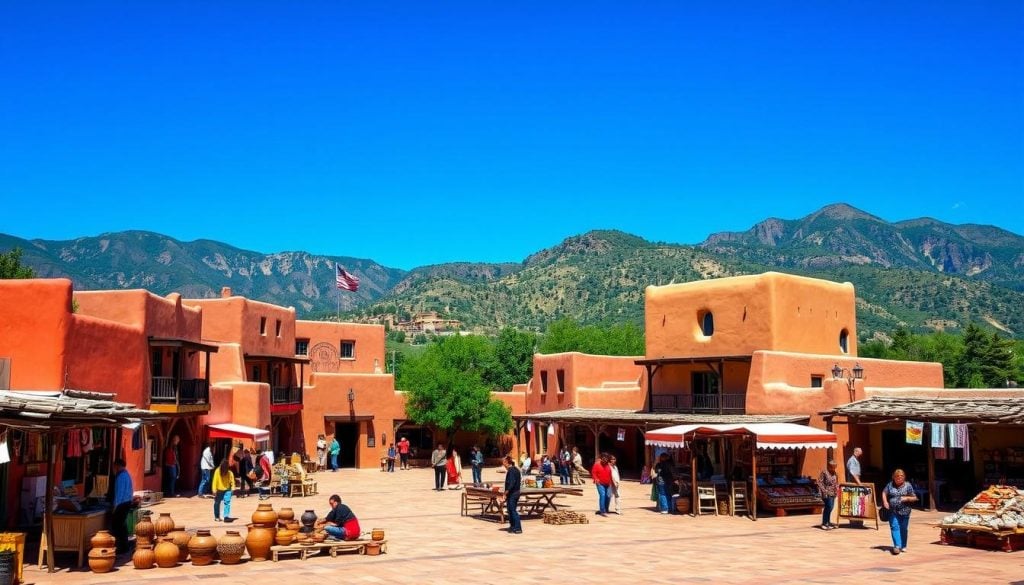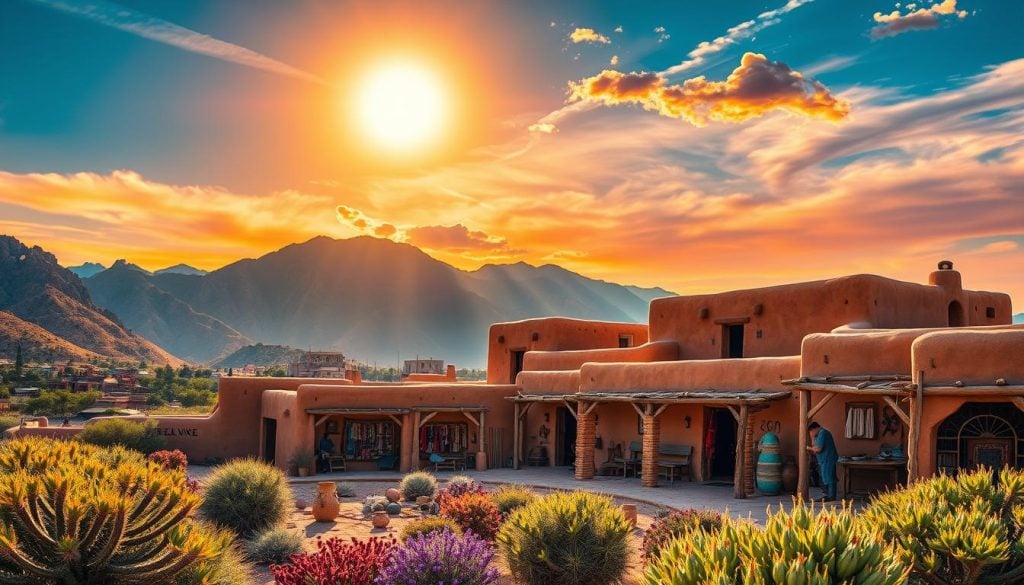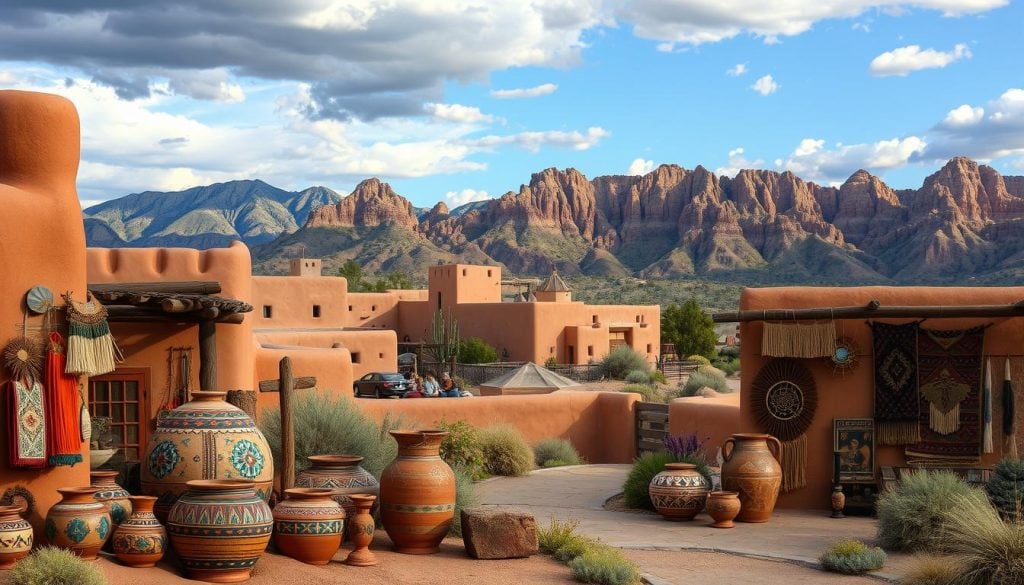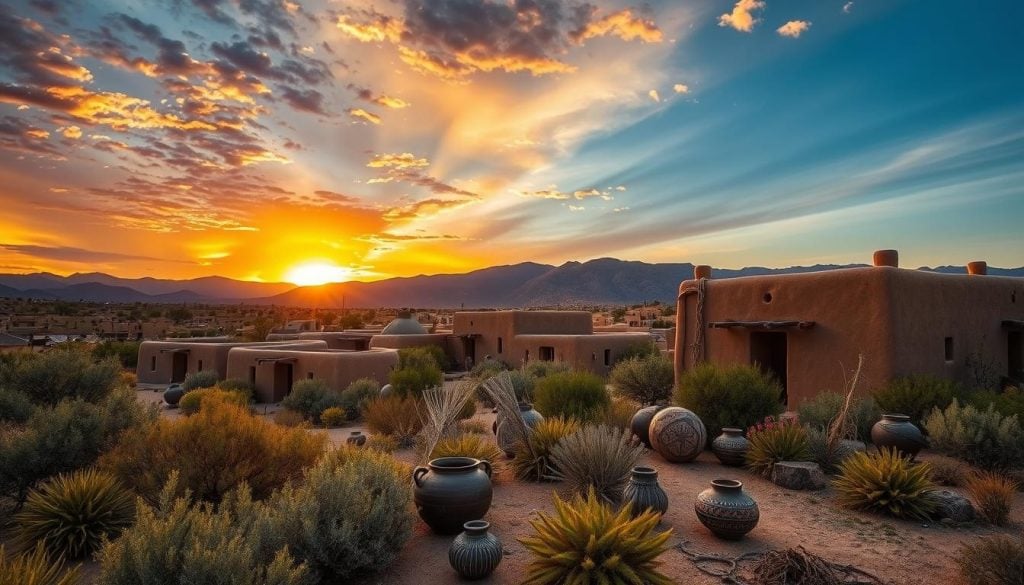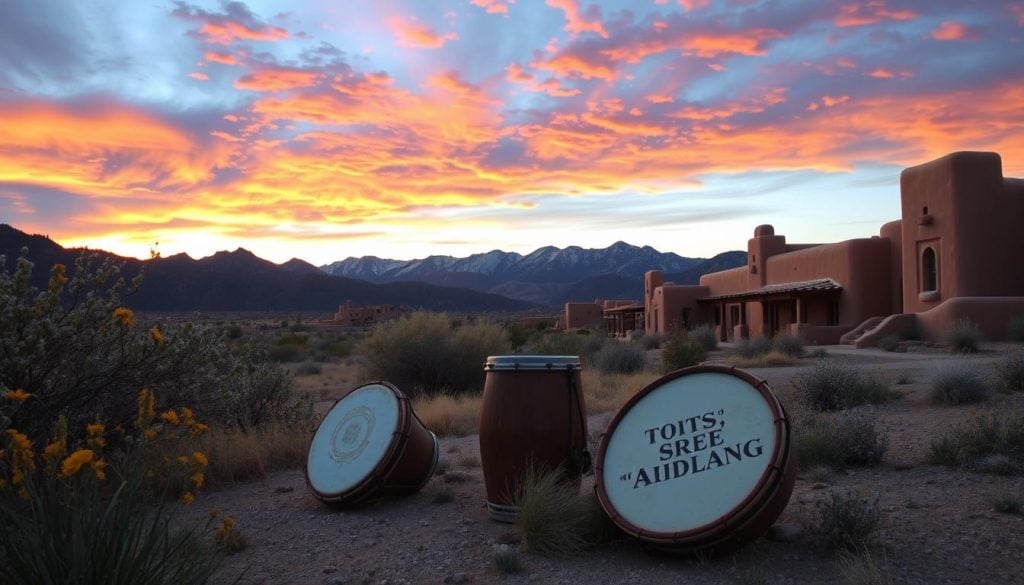Ever wondered about the mix of old traditions and modern life in Taos? It’s tucked in New Mexico’s Sangre de Cristo Mountains. Taos isn’t just a place; it’s a living showcase of history and native heritage.
Exploring Taos’ history and indigenous peoples reveals tales of the Pueblo, Navajo, Apache, and Comanche tribes. Their histories go back over a thousand years. Taos offers a glimpse into the lives and cultures of its earliest inhabitants, particularly the Taos Pueblo, one of the oldest living communities in North America.
Digging into Taos’s past, we find stories of cultural traditions and community festivals that are still alive today. Let’s embark on a journey. We’ll explore Taos’ indigenous culture and its profound influence on the local community.
An Overview of Taos’ Rich Heritage
Taos is like a colorful quilt, made from many stories of people long ago. The Tiwa Indians and Spanish settlers found a way to live together. This mix created a special community in the region. The Taos Rebellion of 1680 shows how strong and brave the Indigenous people were. They helped make Taos what it is today.
Taos’ history is full of things that make it special, like traditional customs, languages, and beliefs. They keep the community strong. By learning about Taos cultural heritage learning, we connect with those who came before us. It makes us feel part of something bigger.
Studying Taos Native American heritage study helps us understand and respect different ways of life. When we celebrate this rich culture, we keep it alive for future generations. It makes our cultural conversations today more meaningful.
The Significance of Taos Pueblo
Taos Pueblo is key in learning about Indigenous culture in the American Southwest. It is a UNESCO World Heritage Site, established around 1325 A.D. It invites us to discover Taos Pueblo traditions. The adobe structures show the Puebloan culture’s architectural skills.
The community’s spiritual life connects deeply with the land. This shows Taos tribal history’s importance. Visitors love the ceremonial buildings and art. This includes pottery and weaving, showing the community’s lasting legacy.
Exploring the traditions here educates on how Indigenous life thrives today. By joining local events or observing the art, there’s lots to learn. This remarkable community offers a great deal to appreciate.
The Formation and Settlement of Taos
Taos’s story began in the early 1540s with Spanish explorers arriving. They were drawn by the Tiwa people’s ancient pueblo structures. By the early 1600s, Taos became a Spanish village. This event was crucial for the area’s history. It led to the blending of European and indigenous ways, affecting how people lived together and governed.
The makeup of Taos today comes from different cultures over time. They used what the land offered to create a thriving place. This teamwork led to a rich economy based on two main things:
- Agriculture, emphasizing the ability to cultivate crops in the fertile soil.
- Trade, which facilitated exchanges between different cultural groups, strengthening community bonds.
Looking into Indigenous Taos community research reveals big changes that made Taos what it is now. delving into Taos’s history teaches us about how cultures merged and evolved together over many years.
| Period | Key Events | Cultural Influences |
|---|---|---|
| 1540s | Spanish Exploration | Initial contact with the Tiwa people |
| 1600s | Establishment of Spanish Villages | Merger of Spanish and Indigenous traditions |
| 1700s | Trade Expansion and Agricultural Growth | Cultural exchanges among various groups |
Learning about the history and indigenous communities of Taos
Exploring Taos’s history and indigenous communities is like uncovering a rich tapestry. It’s full of tradition, innovation, and resilience. The Ancestral Puebloans’ influence stands out, showing how their culture shapes Taos today.
The Ancestral Puebloans and Their Legacy
The Ancestral Puebloans mastered farming in Taos’s unique landscape. They built adobe homes and communal spaces, setting Taos’s foundation. Their approach to sustainability and community lives on. Daily life still includes their rituals, storytelling, and crafts, keeping their spirit vibrant.
Modern Perspectives on Taos Pueblo Culture
Now, Taos Pueblo is a living community that respects its roots while facing today’s world. The indigenous people dive into their culture, connecting old ways with new challenges. Through events and festivals, they celebrate their heritage and its growth.
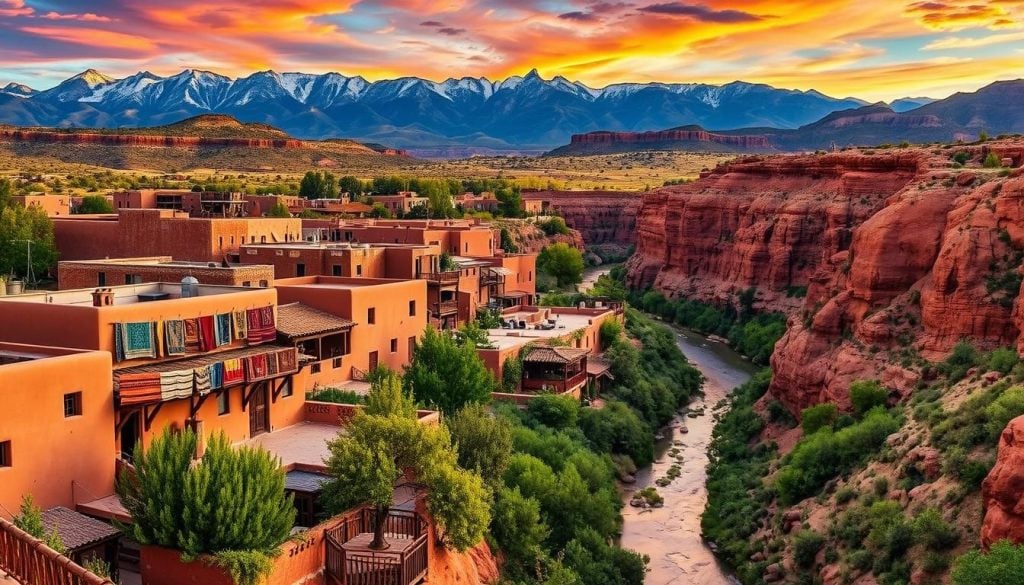
Key Historical Sites in Taos
Exploring Taos means diving into its rich history. The historical sites offer a window into its soul. Visiting these landmarks teaches us about the area’s cultural heritage and its complex past.
Exploring the Taos Pueblo
The Taos Pueblo is alive with history. It shows how the Taos people have kept their traditions alive for centuries. Being a UNESCO World Heritage Site, it connects us to the tribe’s past. You can see their earthen adobe homes and join in cultural events. This helps us understand and value Indigenous traditions more.
The Historic San Francisco de Asis Church
This beautiful church is an architectural wonder from the 17th century. Its adobe structure and Indigenous art show Taos’s mixed culture. The San Francisco de Asis Church is more than a place to pray. It tells the area’s history, inviting us to discover its spiritual and artistic stories.
The Melson-Oldham Cabin Experience
Visiting the Melson-Oldham Cabin offers insights into settler life. It shows how different cultures came together in Taos. Inside the cabin, you learn how early settlers lived. Their stories mix with those of Taos’s Indigenous people. It shows how both groups adapted and persevered in the area.
| Historical Site | Significance | Visitor Experience |
|---|---|---|
| Taos Pueblo | Oldest continuously inhabited community | Cultural activities and tour of traditional homes |
| San Francisco de Asis Church | 17th-century architectural landmark | Art appreciation and historical narratives |
| Melson-Oldham Cabin | Insight into early settler life | Interactive experiences and cultural reflections |
Festivals and Celebrations in Taos
Festivals in Taos are crucial for the community. They show the area’s rich and diverse culture. These events let people learn about Taos cultural heritage learning and connect with local traditions. Throughout the year, different celebrations highlight Indigenous heritage and the spirit of the community.
The Vibrant Taos Pueblo Pow Wow
The Taos Pueblo Pow Wow is a yearly celebration. It showcases traditional music, dance, and colorful costumes. It honors the rich Taos indigenous culture exploration. The event invites everyone to experience the vibrancy of Indigenous culture. Guests can enjoy drum rhythms and see traditional regalia up close.
Fiestas de Taos: A Community-Wide Celebration
Fiestas de Taos focuses on history, music, food, and arts. It combines Catholic traditions with local customs, creating a lively festival. It’s a chance to see local artists, taste delicious food, and hear unique music. This festival shows how Taos cultural heritage learning is alive in community events.
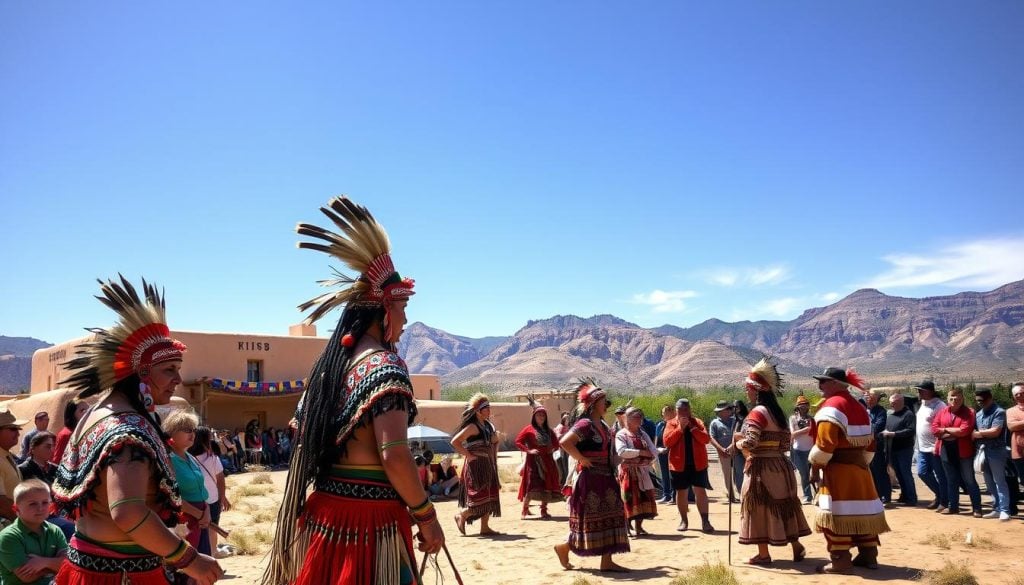
| Festival Name | Significance | Main Activities |
|---|---|---|
| Taos Pueblo Pow Wow | Celebration of Indigenous heritage | Traditional music, dance, art displays |
| Fiestas de Taos | Commemoration of local history and culture | Food, music, arts and crafts |
The Role of Indigenous Art and Crafts
Indigenous art and crafts play a crucial role in defining the cultural identity of Taos. The local artisans are involved in traditional activities that have long histories within their community. These include pottery, weaving, and beadwork, each with its own stories and symbols.
These stories and symbols show the principles and beliefs of the Indigenous Taos community. Understanding how these art forms connect to cultural identity can make your study of Taos Native American heritage richer. Local craftspeople protect these traditions, teaching their skills to the next generation.
You’ll discover that their designs tell tales of ancestors, nature, and spiritual beliefs. Art shows and community markets are key in displaying these crafts. Here, you can meet the artisans. This interaction lets you admire their work and understand its deep meaning.
By being part of these events, you get a glimpse into the Indigenous Taos community’s research. It also supports the artisans. They work hard to keep their traditions alive.
Exploring Taos Tribal History
Diving into Taos tribal history, it’s crucial to grasp the significant roles played by local indigenous groups. These relationships show how communities evolved over centuries. They were influenced by European settlers, changing their ways of life.
The history of Taos’ indigenous people reveals their struggles and resistance. They stood against colonization, showing their communities’ strength. Their culture grew richer through these interactions, leaving a lasting impact on the region.
To better understand this deep history, see the table below. It outlines key details about the indigenous tribes of Taos:
| Tribe Name | Primary Role | Key Historical Events | Cultural Contributions |
|---|---|---|---|
| Tewa | Agricultural practices | Settlement of Taos Pueblo | Pueblo architecture and pottery |
| Apache | Trade and diplomacy | Resistance to Spanish colonization | Oral traditions and storytelling |
| Ute | Hunting and gathering | Land rights negotiations | Music and dance traditions |
Taos Drums: A Connection to Native American Heritage
Drums are vital in expressing Taos Native American heritage study. They are not only about sound. They show a deep link to Indigenous traditions. Drumming is for storytelling, spiritual connections, and bringing people together. This art carries deep meanings about Taos indigenous culture.
Workshops on traditional drum-making let people see how these instruments are made using nature’s gifts. Attendees get to try out ancient techniques. This helps them understand drums’ role in ceremonies and history keeping.
The making of drums often symbolizes unity and spirituality. Every drum tells a part of the community’s story. By joining this tradition, people learn about the enduring spirit of Taos’s indigenous culture.
| Aspects of Drum-Making | Significance | Materials Used |
|---|---|---|
| Techniques | Preservation of tradition | Animal hides, wood, and natural fibers |
| Cultural Role | Spiritual practices and community events | Locally sourced materials |
| Symbolism | Connection to ancestors and nature | Reflects the environment and history |
Conclusion
Taos has a rich history and a vibrant indigenous culture. Its community is closely knit with its past. Taos stands as a tribute to Native traditions, showcasing their survival and energy.
The local indigenous people invite you to learn about Taos’ cultural heritage. This offers a chance to see their unique views and age-old practices. It is an opportunity for deep connection and understanding.
Learning about Taos’ history is key to valuing its complexity. By diving into its culture, through festivals, art, or historic sites, you become a part of its ongoing story. This kind of education helps you appreciate and respect what has shaped this town.
Your experiences in Taos add to the area’s shared culture. By engaging with its living culture, your visit becomes richer. And, you help keep the traditions alive for future generations. Taos is more than history; it’s a vibrant culture to be understood and valued.

































